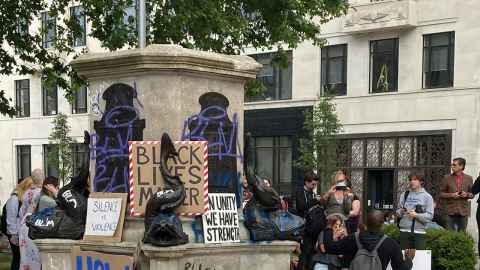To control the past is to control the future
10 June 2020
Opinion: UK protesters who tore down a slave trader statue want a future free from racism - but for that you have to fully reveal the past, writes Neal Curtis.

We are all familiar with the arguments over the status of Confederate statues in the southern states of America. For many they represent a culture that fought to retain economic and political control over the slave trade, and in an age in which the far-right has become resurgent they are seen as anachronistic symbols of white supremacy.
Many have been taken down, but they have once again become the focus of attention during the recent Black Lives Matter protests against police brutality and the killing of black people such as George Floyd and Breonna Taylor.
However, it is not so often that we see such protests in the UK where on Sunday a statue of English slave trader Edward Colston was pulled down by protesters, rolled through the streets and dumped into Bristol harbour. This has, of course, been met with criticism from many quarters that it was an act of crude vandalism, while Nigel Farage rather predictably tweeted that ‘a new form of the Taliban’ had just been born in the UK.
As in the US, there have also been concerns about an attack on British ‘heritage’ and a desecration of history, but neither heritage nor history are simple, uncontested terms. Likewise, people also argue that statues like that of Colston are simply there to remember the past, but as historian David Olusoga has noted, these statues are not a simple act of remembrance but a complex political form of ‘memorialisation’. In other words, the statue is a very particular construction of the past that served the interests of those at the time it was commissioned.
Like the Confederate statues in the US that appeared rather late in the day as a part of a process of reaffirming Southern identity post-bellum, Colston’s statue was also rather late in appearing. It was completed in 1895, but Colston died in 1721. The official justification for the statue would have been because Colston was a celebrated and successful merchant and a member of a company with connections to King James II.
He was also something of a local philanthropist, but why the statue has been the focus of so much recent attention in Bristol is because the company of which Colston was a senior member was the Royal African Company, which held a monopoly by royal decree on the African trade of slaves, gold and ivory from 1672 to 1689. According to another historian, William Pettigrew, it traded more slaves than any other institution, transporting most of an estimated 150,000 to the British Caribbean, a significant percentage of whom died during the passage.
So, why did the statue appear so late? It seems odd that such a man would be commemorated when slavery had been abolished in Britain over 60 years earlier in 1833, but one explanation is that the late 19th century was a period of significant imperial uncertainty. Throughout the European countries with significant colonies, both the idea and the reality of imperialism was troubled or, as the subtitle to Harald Fischer-Tiné’s book on colonial anxieties put it, empires were ‘on the verge of a nervous breakdown’.
The statue, therefore, has to be seen in this context and is a perfect example of what Olusoga calls ‘memorialisation’. It was not simply remembering the past but presenting the past in a way designed to appease the anxieties of the time, and reaffirm the greatness and virtue of Britain. It functioned as ‘heritage’ just as Margaret Thatcher used kitsch Victoriana throughout English cities in the 1980s to promote the idea of national greatness while at the same time selling off national assets and promoting the globalising dogma of neoliberalism.
Just as the placement of 19th century styled balustrades around English parks is not the recovery of history, so, too, the taking down of a statue is not its erasure. In fact, opposition to the statue comes with an attempt to excavate and articulate very real histories that are too often hidden by the dominant versions.
Consequently, this ‘vandalism’ asks us to think carefully about what history is. Too often we treat it as the recording of things that simply happened, and we forget that the writing of history is a social and political process. The historian E. H. Carr, when asking what history is, concluded it is a process of selection and interpretation. First we choose what to record out of all the events that actually took place, and then we write about those events from a particular perspective; we are all familiar with the truism that history is often written by the winners.
To this, I would add one final, important idea linked to what Raymond Williams called the ‘selective tradition’. For Williams, the past is always written in order to serve and preserve the status of the present, while also enabling powerful interests in the present to shape the future: To control the past is therefore to control the future. People protesting against white supremacy are attempting to imagine a future free from racism, but to do that you have to fully reveal history
Dr Neal Curtis is Associate Professor in the Faculty of Arts, University of Auckland.
This article reflects the opinion of the author and not necessarily the views of the University of Auckland.
Used with permission from Newsroom To control the past is to control the future 10 June 2020.
Media queries
Alison Sims | Research Communications Editor
DDI 09 923 4953
Mob 021 249 0089
Email alison.sims@auckland.ac.nz